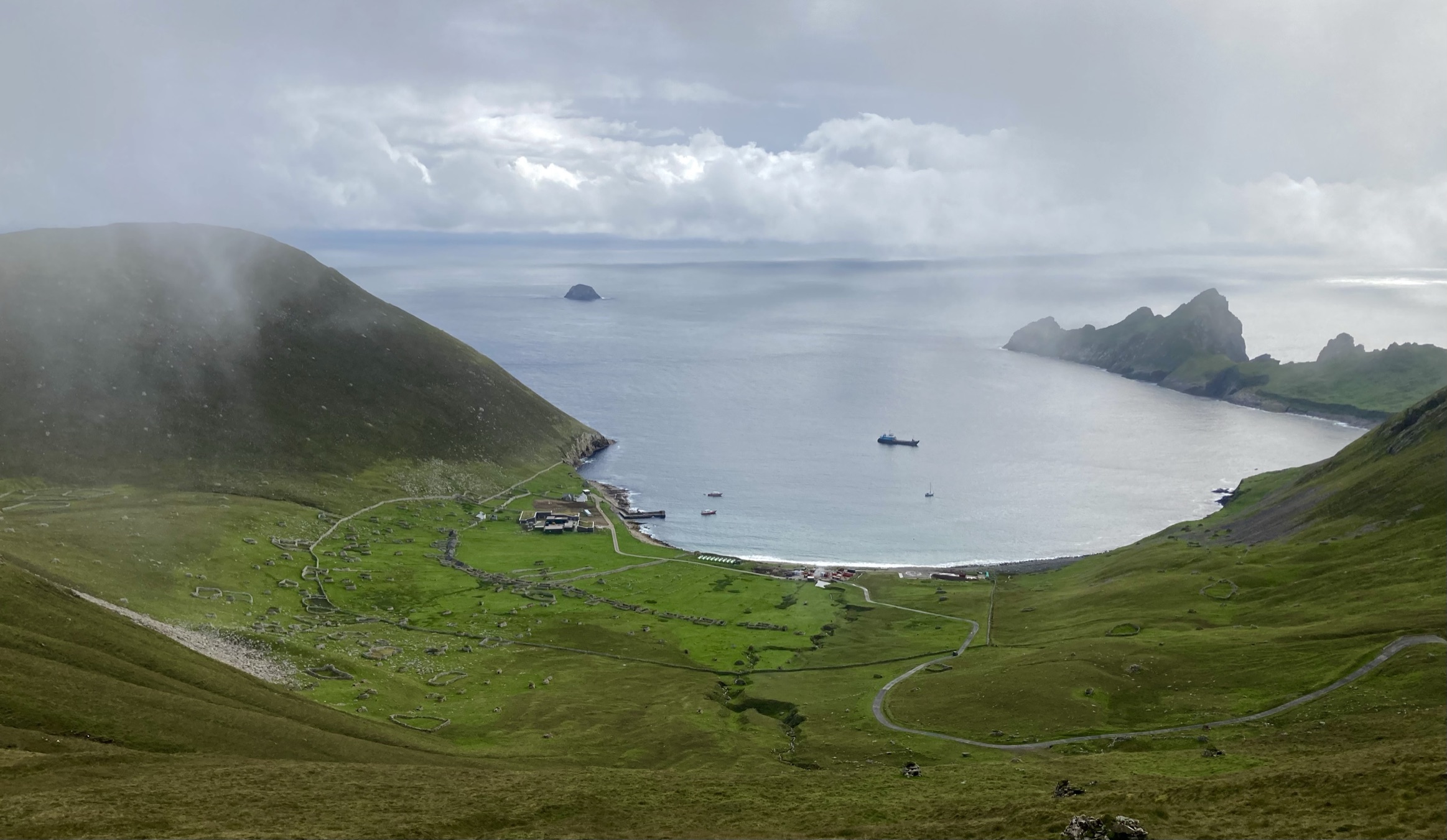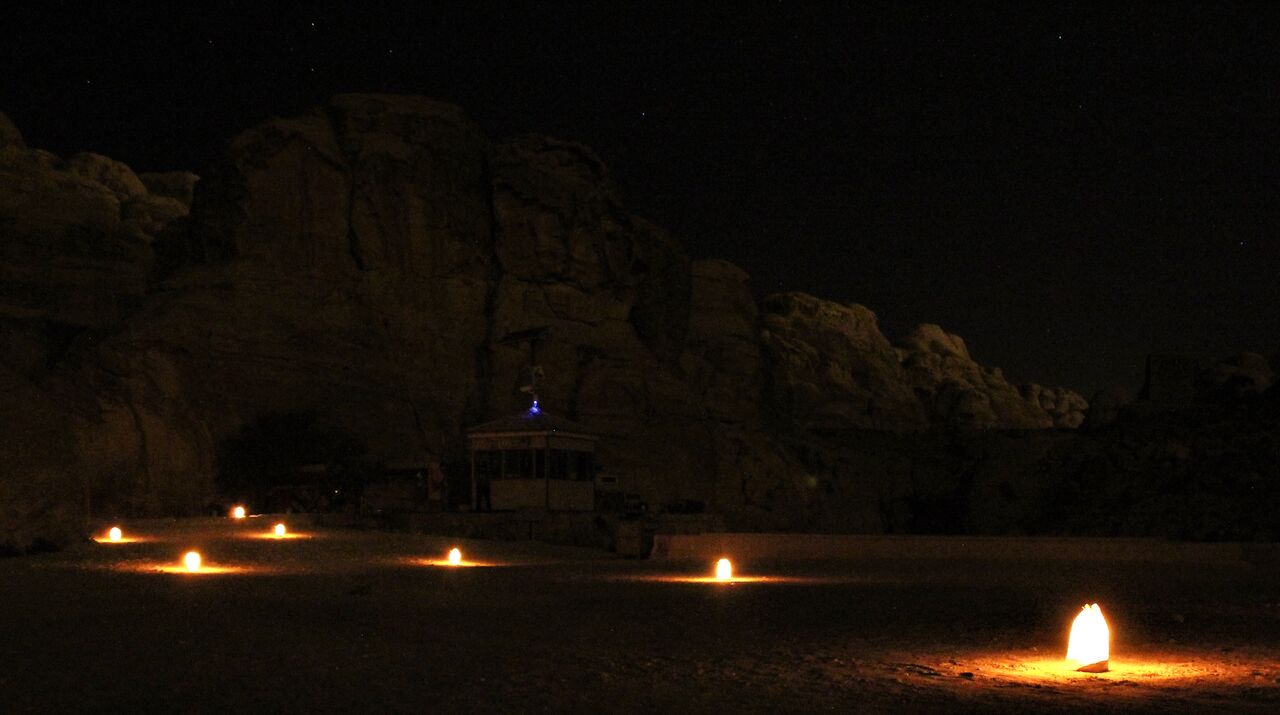Visiting St Kilda: Britain’s most remote outpost
‘Slowly, gradually, the island grew smaller and faded until it was nothing but a blue shadow, dipping below the sea… the sun still made a silver road home, dancing with sparks of light, but we would not tread that way again. We had no right to go back, for the island was to be given over to the birds.’ – Excerpt taken from ‘The Lost Lights of St Kilda‘ by Elisabeth Gifford.
Soaked to the skin. Shivering. Icy cold. Teeth clattering, knees knocking, absolutely chilled to the bone. Hair whipped and blown every which way. Damp bag. Wet socks. Salt spray on my lips. And the biggest smile I’ve worn in a long time.
It is 7.15pm and our boat is just tying up at the harbour in Leverburgh. We’ve been out since 7.45am in the morning. It’s a long day, with nearly five hours spent travelling across the north Atlantic, and yet… It’s been one of the best things I’ve done recently. Certainly one of the most adventurous. Contending with huge swells, seasickness, cold and wet, visiting St Kilda is certainly not for the faint hearted. But it is so worth it!

All aboard Kilda Cruises!
My morning actually starts considerably earlier than 7.45am. At 5am exactly, my alarm shrills and hauls me, blinking and still dreamy, from my warm bed. My generous and warm-hearted B&B host insisted the night previously that she’d wake to cook breakfast before I depart. Sure enough, I can already smell the familiar scents of coffee and fried food wafting down the hall. An hour later and suitably fed, I’m on the road, driving along dark roads through Stornoway and heading south. I drive the length of Lewis and Harris to join my cruise at Leverburgh.
I’m slightly late. I bundle quickly out of the car, throw things unceremoniously into my backpack and speed walk to the harbour. My fellow passengers are all there, milling about, waiting to board. Two vessels are waiting to take their share of St Kilda day trippers – the Sea Harris and the Hirta. It turns out I’m booked onto the Hirta, Kilda Cruises’ boat. I board along with eleven other day trippers. It’s a cool morning, no rain, and everyone chooses to sit outside. That way, we don’t have to wear face masks (a COVID-19 rule for enclosed spaces in Scotland).
The water as we pull away and slowly slide towards the ocean is calm. However, it’s not long before we hit open water and the swells become increasingly large. Mounds of water pile up around the boat. We bob and chunter our way through, ploughing a path regardless. Hill after hill of water is successfully navigated, the boat sliding down and then back up the other side. Each dip and dive makes my stomach leap. As the coastline fades into the distance, I become increasingly unwell with no fixed horizon to focus on.
Dolphin spotting and our first glimpse of St Kilda.
The journey to St Kilda takes roughly two and a half hours. As we reach the halfway point, monotony and an icy chill set in to add to my seasick misery. I grip my seat hard with both hands and close my eyes. When I open them again, I can see a gannet gliding inches above the water. It swerves and manoeuvres expertly between the swells, long wings almost grazing the surface. I long to join it. I want to be free of this tiny boat, bobbing like a cork in the vast ocean! My stomach gives another lurch and I close my eyes again, fighting down bile.
“Dolphins!”
A single cry goes up. My eyes snap open. Suddenly, without warning, our boat judders to an abrupt halt and the engine cuts. In the blessed silence, I can hear only the roar of the water around us and the wind whistling past. Then, suddenly, beautifully, a sleek torpedo shaped grey body slips under the bow of the boat. Seconds later, a dolphin jumps clean into the air. It arches perfectly before disappearing once more below the surface. I am smiling now, a huge, silly smile of joy. My seasickness is forgotten instantly. I lean over the side of the boat, longing to see more dolphins. There! And there! And there too! More dolphins than I’ve ever seen before in one go, thirty, forty, maybe fifty of them!
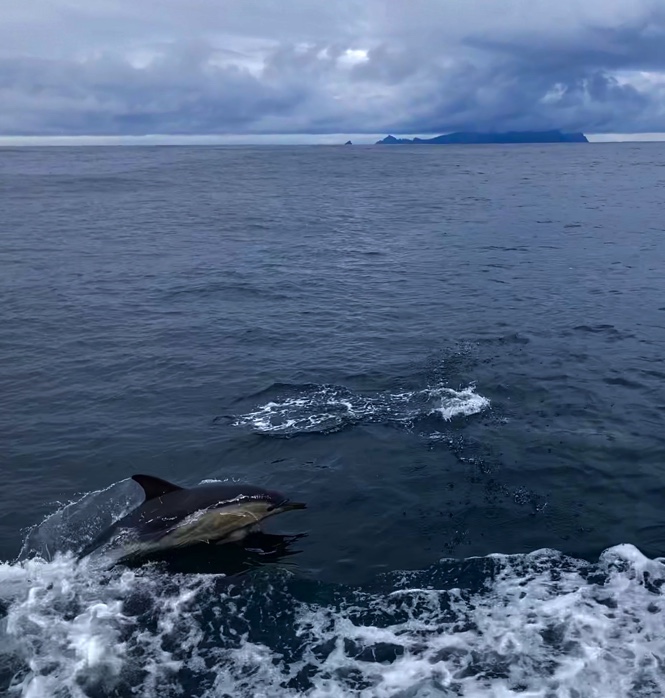
I bounce from one side of the boat to the other, taking videos and photos of the dolphins. They flip and jump and leap around us, so incredibly agile and sleek. I lose count of the number I can see. To add to my joy, we’re finally within sight of St Kilda. The main island, Hirta, is rearing up dark on the horizon. Only another half hour of this torturous boat trip to endure. I can make it!
More dolphins… I snap a shot of one leaping from the water with Hirta in the background. They’re magical creatures. All too soon, the boat’s engine roars back into life. We begin to slip away, leaving the dolphins in our wake. I sit back down and close my eyes once more. This time, the seasickness is gone. I’m filled only with excitement at what I’ve just seen, and for what is to come.
Arriving on Hirta, St Kilda’s main island.
Within thirty minutes, our boat is nosing into a sheltered bay, surrounded by mountains and high cliffs. Suddenly, the water is calm, almost glassy in comparison to the huge swells we’ve experienced during our trip over. Stomachs, previously tightened into knots, ease in moments. The group instantly becomes chattier.
The water is too shallow for our boat to moor up at the harbour. Instead, the anchor is dropped offshore and we are ferried across to the island by tender, six at a time. Finally, hours after we left Leverburgh, we set foot on Hirta, St Kilda’s main island and the only island in the archipelago where boats can land visitors. We are greeted by the island ranger. She gives a brief introduction to the island. Then, we’re free to explore by ourselves for the duration of our stay. The group divides instantly – many take a direct route for the toilet, others, including myself, stroll toward the shoreline.
Behind, the village spreads out around the bay, the main street of houses stretching into the distance. There are countless cleits, the storehouses made of rock and turf, where St Kilda residents once stored their food, fuel and other provisions. They’re dotted everywhere. The tops of mountains, the edge of cliffs, on the shoreline, halfway up steep slopes, throughout the village. The cleits are an indicator of just how tough life was for the island’s residents, and also how adapted they must have been to surviving in the harshest of conditions. I can only begin to imagine what it was like.
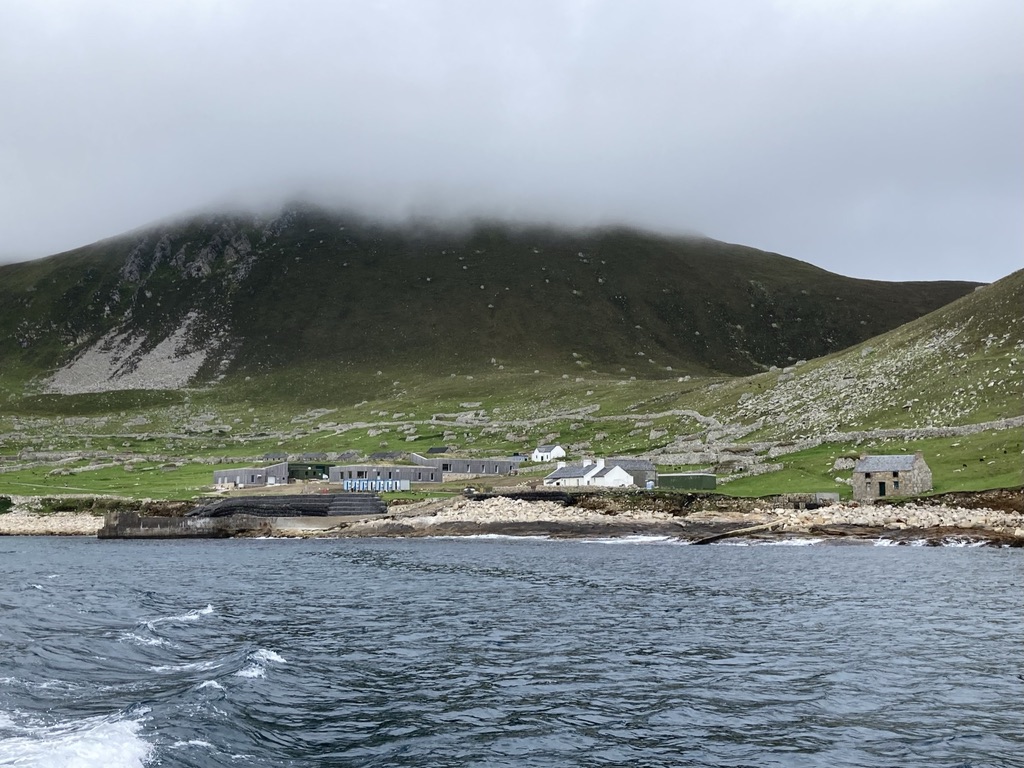
The people of St Kilda.
As I wander along the main ‘street’ of the village, I marvel at how Hirta’s residents lived in this most remote of outposts. St Kilda is thought to have been inhabited for at least two thousand years. Life was harsh. The people of St Kilda survived mainly on birds – gannets and fulmars mostly – using every part of the bird. As well as providing food, the birds supplied oil for lamp fuel, skin to be fashioned into shoes and their bones were turned into needles. Nothing was wasted. In the 19th and 20th centuries diseases brought to the island caused many deaths. As the population decreased, life became harder and the remaining people struggled. In 1930, the last of the permanent residents of St Kilda were evacuated to the mainland for good.
Nowadays, the island is home to seasonal and shift workers. The island rangers stays for the entire summer season and work parties arrive at regular intervals to help maintain buildings and historical artefacts on the island. Scientists visit from time to time to study the flora and fauna. There are also shift workers from a company contracted by the MoD to look after the radar station on the island. Finally, there are regular day trippers throughout the summer season (like myself), as well as people from passing yachts, canoeists who drop by and occasionally, helicopters bring visitors to the island as well. At any given moment, there’s never likely to be more than twenty to thirty people on Hirta.
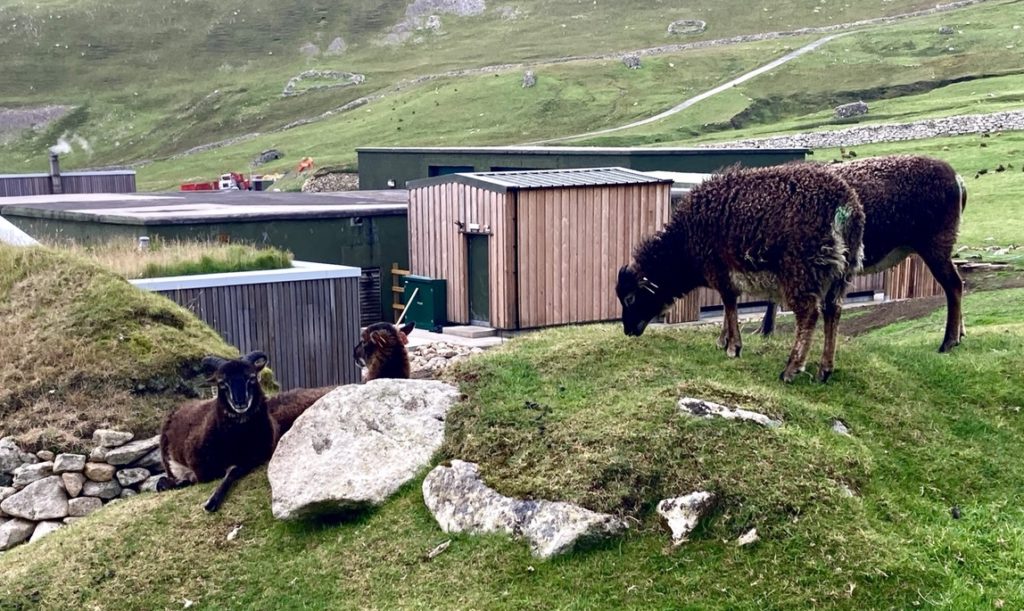
Exploring Hirta – cleits, sheep and a steep scramble.
The lack of people on Hirta makes for a remote, exciting visit. As I amble down the main ‘street’ of the village, I quickly find myself alone. I duck into the old cottages, exploring the ruins and meeting the island’s resident sheep. They’re semi-wild, a breed found only on Hirta, the Soay sheep. They look different to more domestic breeds – leaner, more goat-like.
Above me, I can see other visitors striking out and beginning to climb the hillsides around the village. Eager to see the village from above, I follow their lead and am soon struggling up the only road, which is steep and zig-zags up the hill for an agonisingly long time. Halfway up, bored of road walking, I decide to take a gamble and climb the steep mountainside instead.
A gamble indeed. Within minutes, I’m puffing towards my first cleit that clings precariously to the side of the mountain. Once I reach it, I look back. Already, I know I’m committed. There’s no way I will be going back down that stretch of mountain, with the tussocks of rough grass and steep descent if I slip or fall. So, I turn my face upwards, fix my eyes on the radar tower I can see, and continue climbing.
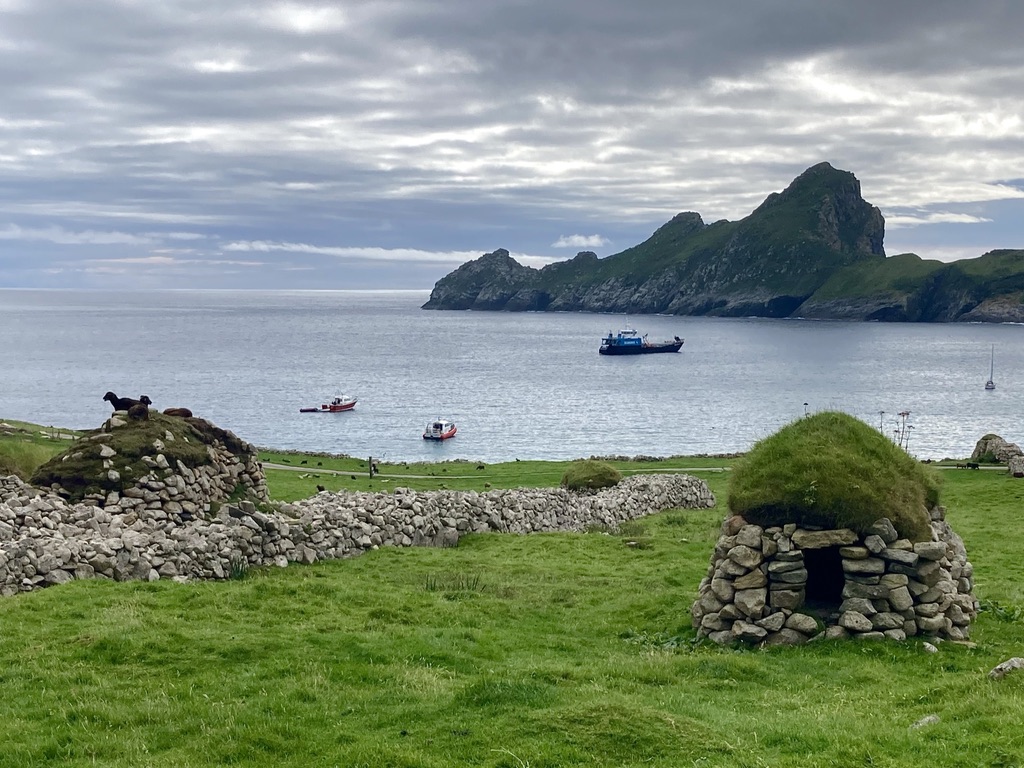
Clouds and rain.
Forty five exhausting minutes later, I triumphantly touch the rough, chill metal of the tower. I’ve made it! Glancing back, I see exactly how steep the ascent was, deeply underestimated by me before I began. In some places, I scrambled hand over foot, never looking down, taking extra care to keep my balance and avoid stumbling. A fall would’ve been potentially catastrophic. Now, I catch my breath, divest my coat and down some water. I’m sweaty but exhilarated. From here, the village looks miniscule. I can see the boats waiting in the bay to take us home later.
As I sit down to eat some lunch and enjoy the view I’ve worked so hard for, the clouds begin to roll in. Typical. Within minutes, I find myself in a murky, grey world. The view is swallowed up. Even the radar tower disappears. I shiver and pull my coat back on. I prepare a quick sandwich and open a bag of crisps, eat rapidly. Although the world has vanished, I can still hear the echoing cries of sea birds. They must be close by. I feel a little hard done by. The whole way up, the sun shone and now it’s so foggy I don’t get the reward of a view. It’s tough luck.
A few splashes of rain turn suddenly into a steady downpour. I scramble to my feet, shoulder my backpack and nose my way back to the radar station. Several times I glance over my shoulder, unable to shake the feeling between my shoulder blades that I am being watched. I marvel at the rapidity of the changing weather, going from bright sunshine to rain and fog in moments.
One minute I’m slapping on sunscreen and the next, I’m sitting in a cloud eating a bag of Quavers!

Viewing St Kilda’s sea stacks.
I safely descend the mountain and reemerge from the cloud. After a brief respite, my group board our boat for the return journey to Harris. We’re greeted with hot drinks and cake, a welcome treat. Everyone is chattering, we’re all exhilarated after our day exploring the island and swap tales of the things we’ve seen and experienced. One woman tells me she’s seen a snowy owl. We collectively mourn the fact we’re a month late to see the puffin colony that normally inhabits the island. That aside, everyone, without exception, has had a wonderful day.
It isn’t quite over. Apart from Hirta, there are three other islands making up the entire archipelago, as well as numerous sea stacks. It’s time to go and see them. We can’t land on the other islands, so the boat will motor around them and we’ll see them from the sea.
Within seconds of leaving the sheltered bay at Hirta, huge swells have splashed over the side of the boat and soaked me. I’m dripping wet. It’s not until later that it becomes a real issue. For now, I drip steadily and, as we approach Boreray, begin to grin manically as the gannet colony comes into focus.
It’s vast. Hundreds, thousands of gannets wheel and soar overhead. They take up every available space on the cliff faces, calling to each other, making an absolute racket. There is an animalistic, musky stink on the chilly breeze. The swells are big around the islands and stacks. The boat motor cuts. We are rocked from side to side, all of us apart from the two crew struggling to find our sea legs.

The highest sea stack in the UK.
Stac an Armin. The highest sea stack in the UK. 196 metres of sheer rock and home to one of the world’s largest gannet colonies. The sheer cliffs, the tales of daring are overwhelming. St Kilda inhabitants used to come these inaccessible islands and sea stacks for days at a time to catch and kill sea birds. In some worst case scenarios, people have even become trapped on the sea stacks for weeks or months at a time before rescue. The thought is unbearable. One group got stuck for nine months on the stack. They survived off the birds they caught and rain water when a smallpox outbreak on Hirta meant that there was no one to save them. It’s hard to imagine.
As it turns out, this is one of my favourite parts of the day. I’m wet through and chilly, but so awed by the sight of the cliffs, the gannets, the swells, the dark blue of the water, the smell, the sheer bleak beauty of the place that I can’t help but grin from ear to ear the entire time. It’s all so incredibly awesome. It’s once-in-a-lifetime.
The final straw is spotting seals bobbing in the waters close to the cliff face. Three or four turn their heads curiously in our direction, politely nosy. Just as the boat engine powers up, just as it’s time to really, truly leave, I take one last, deep breath. The ozone in the air, the magic, I want to capture it and remember it forever. This place is one of the wildest and bleakest, most remote, most extraordinary places I’ve ever had the privilege of visiting. It’s corny, but my heart is full. The day has been everything I hoped it would be, and more.
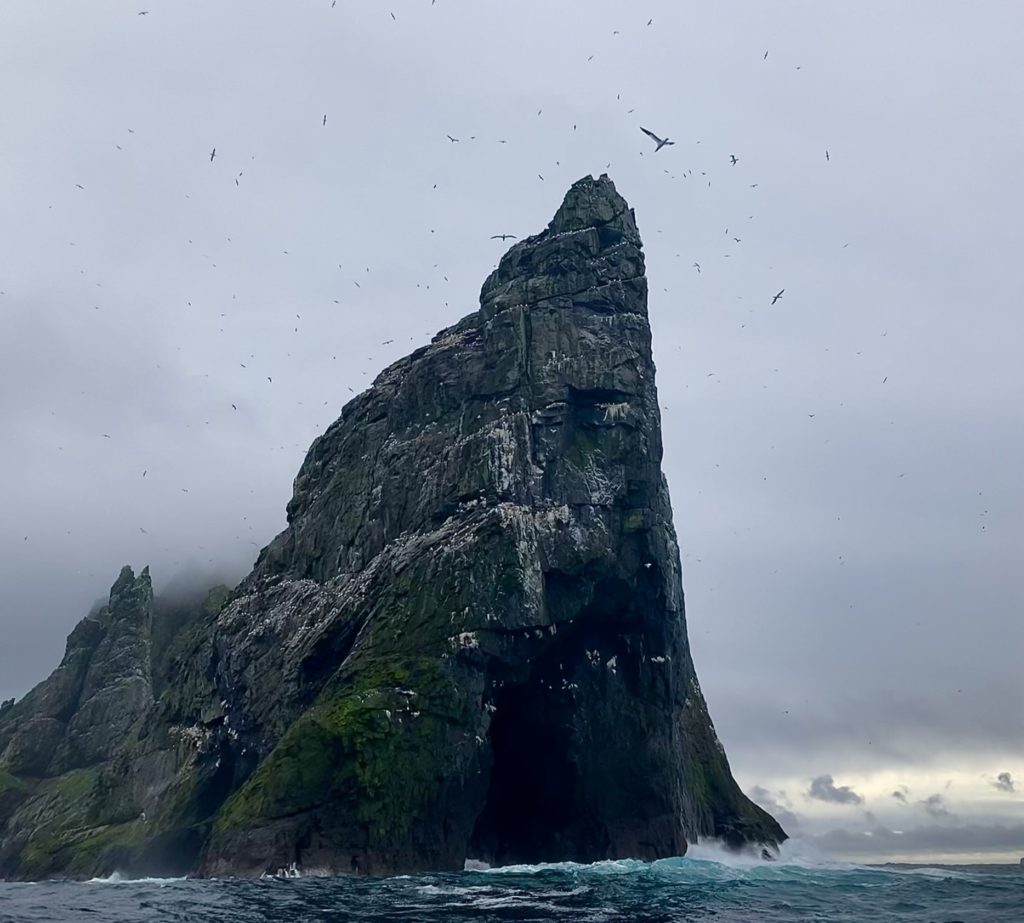
The return journey…
Of course, now that the wonder of the day is behind us, we have the return journey to contend with. As St Kilda fades into the horizon, dark hills rising from the ocean, the sun setting behind them, we settle down. The swells are now behind us. This makes the ride smoother, as we skim across the top rather than plough up and down them. However, I’m now miserably wet and cold.
The journey goes by agonisingly slowly. By the time we tie up, I am the coldest I’ve ever felt. I practically race off the boat to my car to pull on two dry jumpers and crank the heating to the max. It is now 7.30pm. We’ve been out for nearly twelve hours. It’s definitely a long day, and there have been moments of struggle. However, it’s also been one of the most wonderful things I have done in a long time. A highlight of my visit to Scotland. As the heater slowly thaws me, I smile again. It’s been a magical day.

Top tips for visiting St Kilda.
Practicalities for visiting St Kilda.
- Book early. There are only two boats running daily throughout the summer months, and they each carry only twelve passengers. They book up fast! I booked with Kilda Cruises. The other option (with a slightly faster boat) is Sea Harris. As far as I can make out, both tour companies do almost identical trips.
- Take lots of warm clothing. More than you think you will need. I took two jumpers and a coat with me and I still froze on the boat home. I’d recommend taking an extra hoodie or fleece to pop on for the return journey, and try to take waterproof trousers as well as a waterproof coat!
- Wear sturdy boots. Hirta is a rugged island. You will encounter mud, puddles and sheep poo! Wear footwear that can withstand the challenges, and that you’re comfortable in.
- Make sure you take lunch and water. There are no places to buy food on Hirta. Pack a picnic and plenty of water, plus snacks if you think you’ll get hungry!
- Be prepared for a rough crossing. It’s two and a half hours each way from Leverburgh to Hirta. It’s a rough sea. You’ll be cold at some point, for sure. You might also get seasick, and you might get wet. The experience is worth it, but be aware beforehand to plan better and remain as comfortable as possible!
- Book accommodation near to Leverburgh. It’s an early start and a late return – I’d recommend staying in or near Leverburgh the nights before and after your trip to avoid long drives either side of a long day!
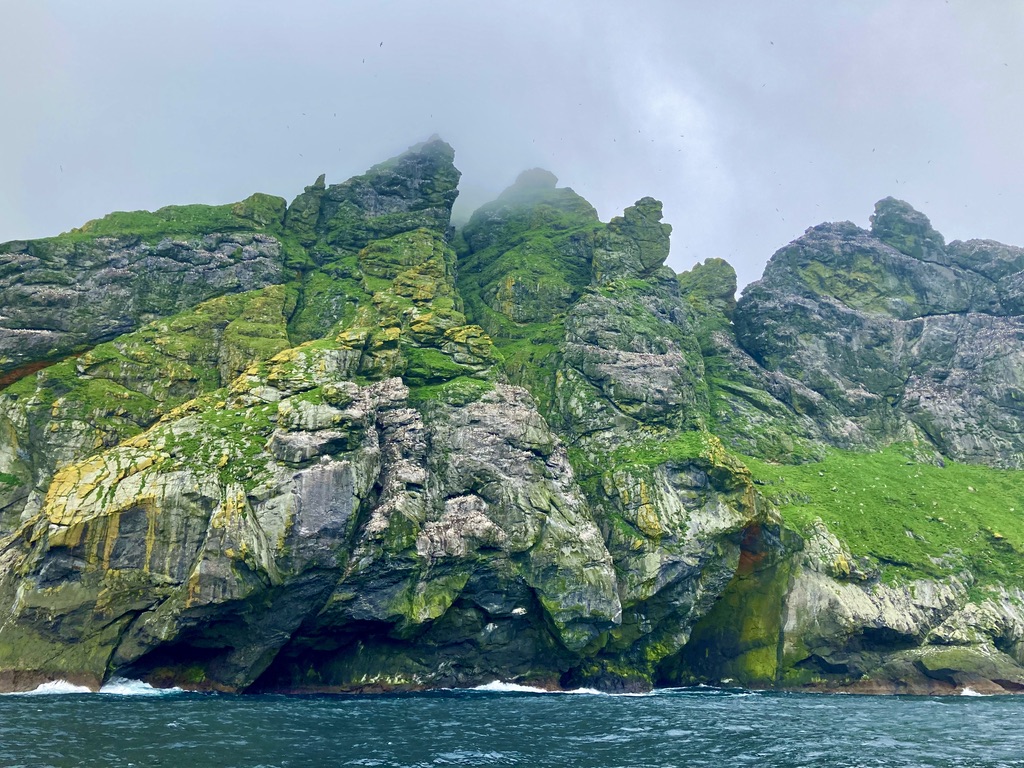
On the island.
- Take some change. It’ll come in handy if you want to purchase a postcard or souvenir from the small shop on Hirta (yes, there is one!).
- Be respectful. The island ecosystem is delicate and there are a lot of rare flora and fauna. Keep your distance from seabirds, watch where you tread, don’t leave litter, make sure you disinfect your boots where requested.
- Be cautious. When I visited, there were building works ongoing. Don’t get in the way of construction workers or contract workers. Make sure anyone operating heavy machinery is aware of your presence before you go walking across a work area!
- Don’t worry about toilets. There is one on the boat, but there are also two available on the island, so you’ll never need to be concerned about holding it in!
- Visit April-August to see the majority of seabirds. I went in September and we just missed the puffins! I was pretty bummed about that. If you’re a bird nerd, don’t make my mistake and travel to St Kilda during the summer months for the best chances to see a wide variety of birds.
- Pay attention to the warden’s safety tips. They know best the conditions on Hirta, so if they tell you not to go somewhere or to avoid a certain route, pay heed! Don’t be the idiot who needs to be rescued or who gets hurt because they didn’t listen to the safety advice!
Finally: Want to read more about my travels in Scotland? Visit the Scotland archives and have a browse!

